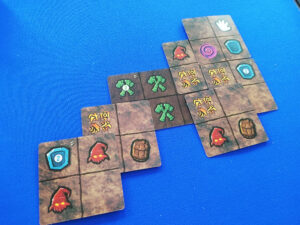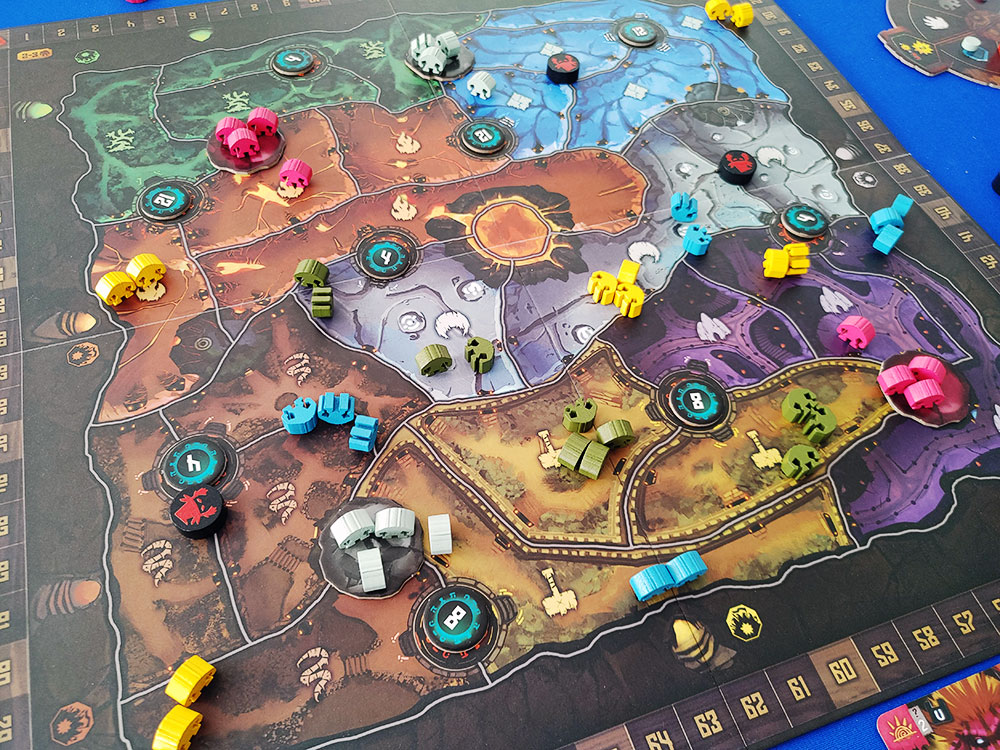 Sometimes we here at Board Game Quest Headquarters are assigned jobs—like that one time we all voted to put Jason Kelm on latrine duty for a month. Other times, our reviews are labors of love, earned via a passionate plea to our somewhat benevolent publisher Tony Mastrangeli—like that other time when Brian Biewer demanded he be the one to review Frosthaven, but then took too long to even open the box and Brandon Bryson took over.
Sometimes we here at Board Game Quest Headquarters are assigned jobs—like that one time we all voted to put Jason Kelm on latrine duty for a month. Other times, our reviews are labors of love, earned via a passionate plea to our somewhat benevolent publisher Tony Mastrangeli—like that other time when Brian Biewer demanded he be the one to review Frosthaven, but then took too long to even open the box and Brandon Bryson took over.
And other times, we get review copies for reasons that can best be described as “Tony’s random decision-making process.”
“Chris, I think you’re the perfect guy to review Burnt Island Games’ Fall of the Mountain King,” said Tony at the BGQ water cooler.
“Why’s that?” I asked. “Is it because I own (but have never played) the spiritual predecessor ‘In the Hall of the Mountain King’? Or is it more because it’s widely known that I am ‘the King of the ’Q’?” I added, hoping that my attempt to make “the ’Q” a new nickname for the site would be met warmly.
“Neither,” he replied lazily. “I’m pretty sure your house is the closest to mountains among the staff and I’d like you to frame the review around that knowledge.”
My shoulders dipped. “Oh. Okay.”
“And don’t call my website ‘the ’Q’ ever again.”
Gameplay Overview:
Fall of the Mountain King is a 1-5-player area ??majority?? game (more on the ??s in a bit) broken into three rounds (called “Waves”). Each Wave consists of the following phases:
- Building an Ancestry, which is the act of adding cards to a player’s personal Ancestry tableau.
- The Battle, which is the section of each Wave where players take their turns.
- End of the Wave, which is essentially the upkeep phase of the round.
- Refresh, which is the preparation for the next Wave or the end of the game.

During the first phase—the portion where players work on their Ancestry—players will draft cards that have between one and four symbols on them. These cards will then be added to similar cards already in a player’s tableau by covering one or more other square sections of previously placed cards. Players will add three such cards to their Ancestry every wave and the actions that remain uncovered will dictate what they can do during the Battle phase. After the draft, players will mark what they’ve collected by developing their Ancestry this phase. Grouped actions become more powerful so keeping symbols clustered is advantageous.
The Battle phase lets players use these actions, one by one unless they’re part of a cluster, to impact the game. In the simplest terms: players get to do the stuff they have in their ancestry. There is a somewhat clunky subset of rules in which players can perform two so-called “Weak” actions and one “Strong” action. Strong actions are either symbols with a number on them (indicating their power) or symbols that are clustered with like symbols. Weak actions need to be taken before strong ones.

Here’s a brief rundown of the four actions players can take based on their Ancestry:
Advance – players move their trolls around the board.
Bolster – players add trolls to empty sections of the board.
Influence – players can use this currency to recruit Champions to their troll team. (Yes: players’ group of units are referred to as a “team” in the rulebook.)
Gnome – players will move a token around the cleverly named “Gnome Wheel” to get benefits. (It bothers me that the name of this action isn’t a verb, though I guess the verb “to Gnome” could become a thing.)
Some of these actions trigger other things—Advancing into an occupied territory can lead to a West Side Story-type Gnome battle, for instance. The Gnome Wheel also has tripwires built into it, which can cause Gnome invasions. Another of these “checklist” items that can trigger after an action is a quick battle that occurs when a player’s trolls enter an overrun cavern. (“Overrun cavern” and “quick battle” are two of the game’s more nebulous concepts.) If you win this conflict, there is a four-step process that needs to be followed in order to receive the associated rewards. It’s not quite overwhelming, but processes in the middle of the action phase like this require frequent visits to the rulebook.
Players play three waves in this manner, with each successive one having different scoring calculations for controlled areas (more rulebook checking). At the end of the third wave, final scores are tallied and the player with the most Honour is the best troll ever.

Game Experience:
As with most (maybe all?) area-control games, the basic idea of the game is simple: expand the units using the mechanisms that exist in the game. In some games, it’s by spawning new units in adjacent spaces. Some games have players triggering actions that, if played intelligently, can shuffle your minions creatively around the board. Fall of the Mountain King has a little bit of those things, but there is also a lot of troll movement involved and while thematically sound and not terribly complicated, it can sometimes be bogged down by the minutiae of its ruleset. Often we were playing along just fine until we realized that we forget a certain aspect of the movement that would have greatly improved one of our turns 15 minutes ago. Obviously, this is as much of a flaw with my brain as it is anything else, but I do find that a concept as simple as “moving” is made overly complicated here.

In fact, I’d say that’s the biggest issue with this game overall. It’s not a very difficult game to grasp or even play, but teaching this is something of a grind. (The rulebook is pretty good at explaining things, but it’s already a daunting prospect when the “Game Setup” section contains four different sections covering various parts of the play area.) This might fall under the category of “fiddliness,” but in addition to the small, nitpicky rules that most modern games usually have, there is also the sheer amount of stuff that players need to not only understand, but also cohesively manage from turn to turn.
For instance: every player has a starting Champion troll at their disposal. Some of these trolls come with physical bases placed underneath the troll meeple. (These bases also aren’t printed that great, which can make reading them later in the game tricky at best and frustrating at worst.) Players can also fight Gnomes and these Gnomes come from certain directions that also have very specific rules attached. And all this stems from the game’s best mechanism: the maybe-not-innovative-but-still-neat tile-laying Ancestry tree, which is a delight to puzzle through how to best maximize actions every turn, but which also adds another unwieldy aspect to the game.

AP becomes a real issue as players constantly have to juggle the order they want to do things and keep track of all the stuff they’ve acquired and can do every turn. Plus, in addition to the strain that the game itself imposes, there’s also the “scripted” nature of many of the game’s mechanical elements. This is a feature of a lot of Euro games; a certain event will trigger a checklist that needs to be followed in order or the entire game crumbles under its own weight. Teotihuacan: City of Gods has this when an eclipse is trigged and there are other examples as well. Fall of the Mountain King has no fewer than three such moments. It’s not the end of the world, but it does tend to grind any momentum that the game develops down into a “do this, then that” endeavor.
Final Thoughts:
As I said at some point, there are a few standout design elements in Fall of the Mountain King that are definitely worth a look if upper-middle area control games are your jam. The Ancestry minigame is a lot of fun to manipulate, and the ability to have unique units from a large pool of possibilities is also a solid idea, even if it’s not implemented flawlessly in regard to the way the components are used.
And to say my overview of gameplay is only a fraction of what actually goes on during the game would be an understatement; there is a ton of stuff everyone needs to track. I didn’t even mention concepts like how the Champions really work or the Invasions that occur at the end of every phase. (This website only has so much ink at its disposal.) There are so many edge cases and such a rigid structure to the way each wave plays out that it’s very difficult to internalize every aspect of the rules.
Nothing is terribly intuitive, which is an issue in a game with such a dense ruleset. Perhaps if this was a weekly favorite for a game group, it would flow more successfully when played regularly, but I found myself having to look up multiple things on nearly every turn, thereby grinding any momentum the entire experience had to a halt.
Ultimately, though, Mountain King 2: Electric Boogaloo has just a bit too many moving parts to feel like a streamlined game. Maybe a few more rounds of playtesting that led to the trimming out of a mechanic or two would have helped the base version of this game feel less clunky than it can at times. As it stands now, however, Fall of the Mountain King falls well short of its intended mark. (You’re welcome for that one, Dear Readers.)
Final score: 2.5 Stars. A decent idea with a strong action-selection minigame mechanism that has too much other stuff going on to be successful.
 Hits:
Hits:
• Ancestry minigame is a standout design choice
• Some interesting ideas with the way areas are controlled and units moved
Misses:
• Bogged down by a bunch of difficult-to-remember rules
• Table hog
• Fiddly
• Set up and tear down is a kind of a nightmare
• Scripted nature of in-game upkeep gets repetitive






















Totally agree – and yes, it’s already way into the “fiddliness” realm, to me. Plus the gnome invasions kind of make everything that came before almost irrelevant! The (official) solo mode doesn’t fix things either: https://boardgamegeek.com/geeklist/316593/solitaire-games-your-table-june-2023?itemid=9852515#9852515
Completely agree… And would apply most of the caveats about the game to it’s predecessor (doubly so…) It’s just a fiddly grind, too many seemingly arbitrary mechanics and rules; it’s like not enough neutral play testing was done .
With hall I backed , played a few times and sadly sold on as a great game buried in there…. Fall I didn’t back to try it; and very glad I didn’t spend money on it ; once bitten twice shy
I love BGQ’s honest board game reviews.
I loved the intro, and figured that review wasn’t going to be great if we started off with that entertainment 🙂